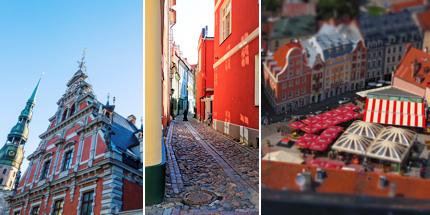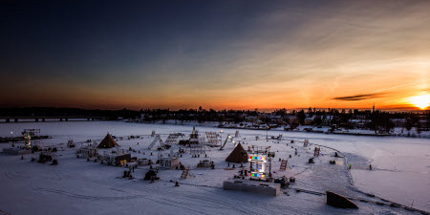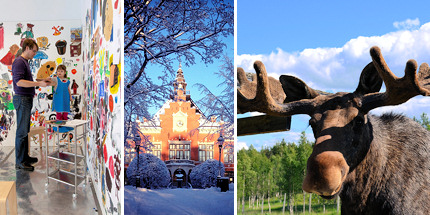Riga vs Umeå: Capitals of Culture go head to head
We pick apart this year's Capitals of Culture. Who will win - Latvia's dazzling capital, Riga, or the Arctic Circle splendour of Sweden's Umeå?
Rudolf Abraham sticks up for Riga
Riga - isn't it all stag and hen dos?
Maybe once upon a time, but not at all now – I didn’t spot (or hear) a single one during my stay. This is Latvia’s cultural heart, so the range of visitors it attracts varies hugely.
So what's special about it? Apart from the fact that it's European Capital of Culture...
A UNESCO-listed old town centre, it has one of the greatest concentrations of art nouveau architecture anywhere in the world, and more museums and galleries than you can shake a stick at. Need anything more? Well, there’s the bread – Latvian food is very tasty, but the bread is truly heavenly.
What's worth seeing in terms of culture?
Loads – Riga has a hugely impressive range of architecture, spanning some 800 years – from the late romanesque, gothic and baroque periods, to Renaissance merchant houses and guild buildings, renovated 19th century wooden housing (especially in the Kalnciema iela quarter), and the enormous converted zeppelin hangers of the Central Market, one of the largest and oldest markets in Europe.
At the heart of the UNESCO-listed old town, the Dome Cathedral (don’t be fooled – it’s more spire than dome) is an enormous red brick building, and the old, painted wooden floorboards inside make you feel as though you’re wandering around the decks of a ship.
 Pretty Riga is full of architectural marvels
Pretty Riga is full of architectural marvelsThinkstock / iStockphoto; Creative Commons / dierken
Defining Riga’s unmistakable skyline is the spire of St Peter’s Church, the tallest in the city. The extraordinary concentration of art nouveau architecture is one of the most impressive anywhere in the world, accounting for around a third of the buildings in the city centre – and at the end of Kronvalda Park, you’ll find street after street of elaborately sculpted, pastel-coloured facades.
A whole raft of museums and galleries are scattered though the capital. Standouts include the Latvian National Museum of Art, the Museum of the History of Riga and Navigation, the Museum of the Occupation of Latvia and just outside the city itself the Open-Air Ethnographical Museum (with its collection of traditional wooden architecture). A huge number of events and festivals are taking place throughout 2014, from opera and blues to ballet and contemporary theatre.
Anything I can skip?
You can easily fill up a couple of days just wandering around the old town centre and art nouveau areas, so don’t start planning trips out of town unless you’ve got more time than that.
I've had my fill of culture - what else can I do?
Eat, drink and be merry. The old town in particular has a wonderfully vibrant concentration of cafés, bars, pubs and restaurants along its narrow cobbled streets and atmospheric city squares. Wander over to the main market, housed in a series of cavernous former zeppelin hangars, for a colourful and authentic slice of daily life in the Latvian capital – as well as more smoked fish than you’ve probably ever seen in one place in your life.
With Latvia being quite a small country, it’s effectively possible to see much of it in day trips from Riga. Head out to the beaches at Jūrmala, which can be reached in under 40 minutes. It has 30km (19 miles) or so of pale sand and was awarded with EU Blue Flag status in 2000, though not surprisingly, the water is, shall we say, on the cool side. Just 25km (16 miles) from Latvia it makes an easy day trip, with gorgeous scenery, thermal mud pools and seafood restaurants aplenty.
For more information on Riga visit www.liveriga.com.
 Skip the culture and head out into the wild
Skip the culture and head out into the wildHakan Larsson / Umea Tourism
Ingela Hjulfors Berg makes the case for Umeå
Umeå - where the hell is it? And what's so special about it?
No doubt you've already heard about Riga. Umeå on the other hand, you're probably still having trouble pronouncing. Well, it's 'u-may-o'. Umeå is actually situated along the coast of the Baltic Sea, one of the last cities before the polar circle. Oh, and to answer your (unbidden) question – yes it’s a real city. With normal people. 118,000 of them in fact.
What's worth seeing in terms of culture?
Culture isn’t just galleries and museums; in Sweden, music’s pretty high on the list. Umeå is no exception. To combat the blues induced by the long winters this far north, Umeå holds a Jazz Festival every October. It’s been running since 1968, making it Europe’s oldest, and it is still among Scandinavia’s largest jazz festivals.
Despite the reputation for ABBA-love, northern Swedes like to go to the opera. Created in 1978, Norrlands Operan is the city’s opera house and one of the strongest drivers of culture in the region with both modern and classic performances showing all year round.
Still, they do know how to rock. As well as having lots of local bands, there’s now a dedicated space for the icon of rock: the guitar. The newly-opened Guitars - The Museum is one of the world’s largest privately-owned vintage guitar collections, with 500 electric and bass guitars, and amps. There are enough instruments here to start a very large electric orchestra.
If music isn’t your thing, the local art museum Bildmuseet (the Museum of the Image) situated along the riverbank, is a centre for contemporary art and visual culture as well as a place for experience, reflection and discussion. Designed by Henning Larsen Architects in collaboration with White, the building is definitely one of the most striking in the city. It was nominated for the European Mies van der Rohe Award 2013 – so the architecture buffs can geek out too.
 Umea may be small but it packs a cultural punch
Umea may be small but it packs a cultural punchUmea Tourism
Photography fans should visit the Sune Jonsson Centre for Documentary Photography at the Västerbottens Museum, which has an exhibition by famous local photographer Sune Jonsson’s depicting regional life in Västerbotten from the 1940s up until the 1960s. The centre also holds workshops, seminars and a photo archive, so you can get a sense of just how much Umeå has changed.
Anything I can skip?
Umea's pretty small, so you're unlikely to need to skip things but if you’re short of time, don’t miss the Bildmuseet.
I've had my fill of culture - what else can I do?
Umeå is the gateway to Sweden’s epic natural landscape – meeting an elk here is like meeting a sheep in Wales... sort of. If you want to get up close and personal with the ’king of the forest’, take a day trip to Älgens Hus, an elk farm around 80km (50 miles) outside Umeå, where visitors can pet these beautiful animals.
For more information about Umeå visit www.umea2014.se/en
Do you have any Feedback about this page?
© 2025 Columbus Travel Media Ltd. All rights reserved. No part of this site may be reproduced without our written permission, click here for information on Columbus Content Solutions.









 You know where
You know where